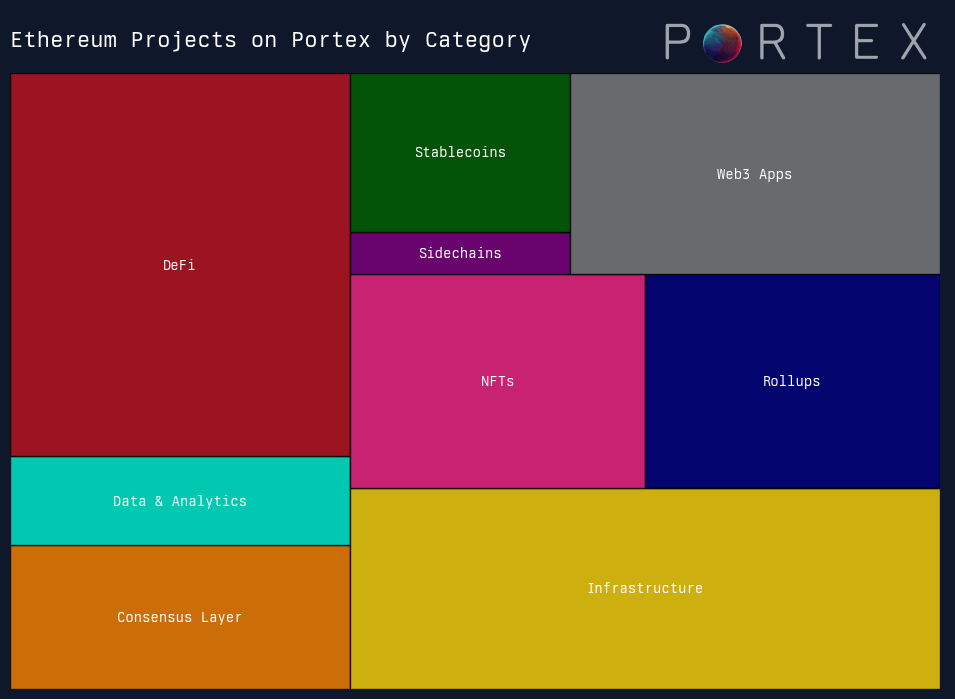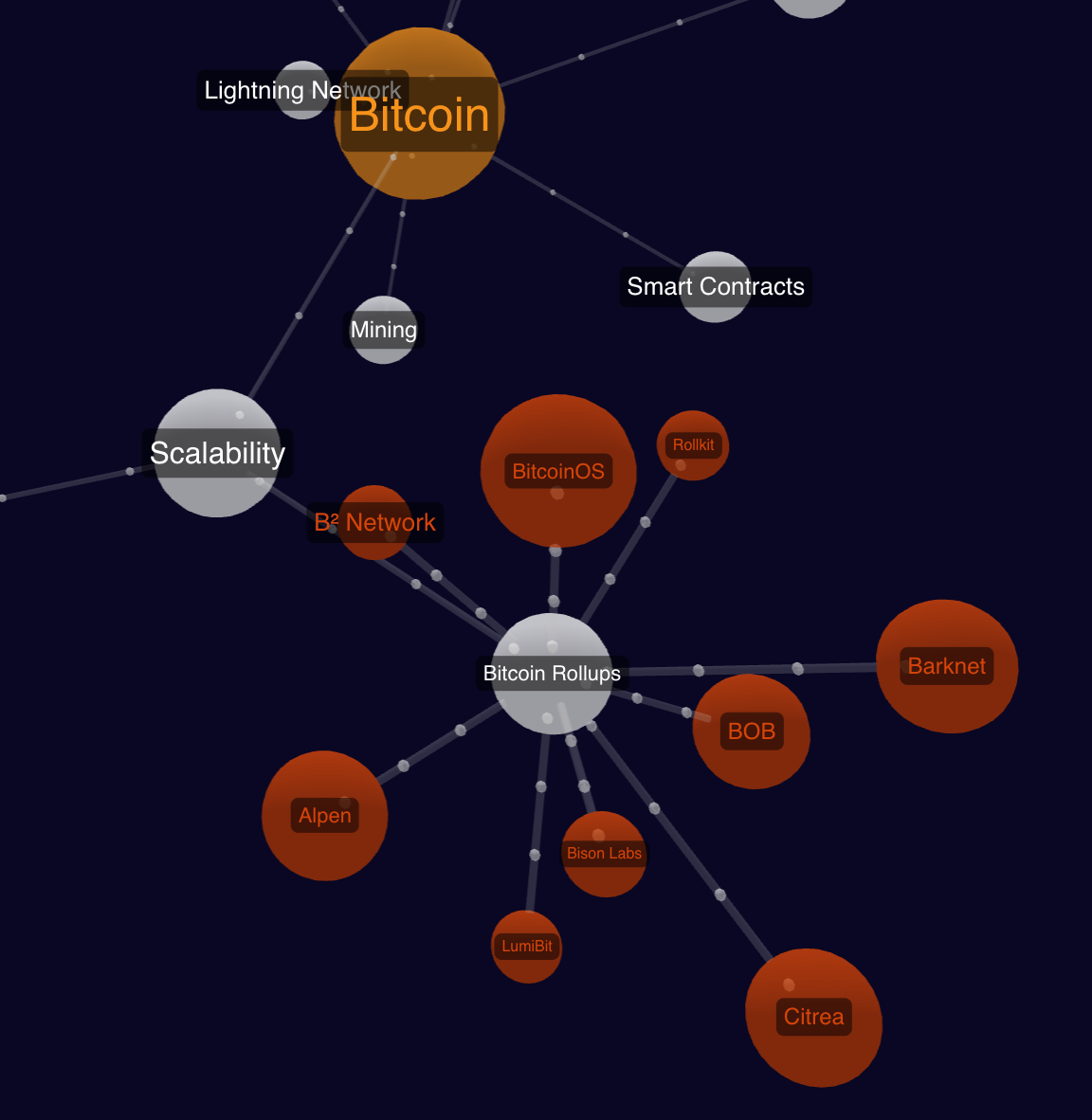Mapping Crypto Primitives in 2024
Capturing innovation across the Bitcoin, Ethereum, and Solana ecosystems.

At Portex, we’re really excited about the growing library of crypto primitives being contributed through the Portex platform. We have a strong conviction that capturing innovation in the technology stack is a critical step in accelerating the adoption and development of onchain applications.
As data-driven researchers, we’re also curious to explore the changing nature of these ecosystems more rigorously. So even as the Portex platform evolves, we plan to periodically take a step back and look at the data to understand each ecosystem’s growth. In this article, we explore the Bitcoin, Ethereum, and Solana ecosystems, highlighting recent innovations and project types that are commanding a strong presence across the 400+ projects mapped on the Portex platform thus far.
Bitcoin Ecosystem
Building on Bitcoin: the Emergence of Bitcoin Rollups
As Bitcoin passes its 4th halving, 2024 has the potential to be one of the most significant years for innovation on Bitcoin. This is particularly true of efforts to achieve greater scalability on Bitcoin, one of the biggest categories mapped on the platform today—tracking the various Sidechains and Rollups now being built on Bitcoin. The treemap below captures the number of projects we’ve integrated onto Portex’s Bitcoin graph by their respective categories.
Even though the Lightning Network is a project that aims to improve Bitcoin’s scalability, we account it as its own category in the platform given how technically distinct payment channels are to the Rollups and Sidechains in the scalability category. This distinction also enables us to better monitor the explosion of new Bitcoin Rollups and Sidechains projects being built—including 7 Bitcoin Rollups that were launched or announced in the last year, and that we’ve already integrated onto the Portex platform.

Bitcoin is currently witnessing a Renaissance with waves of experimental projects attempting to increase its functionality and scalability. This is largely driven by the advent of Ordinals, which have opened the floodgates for different types of data that can be posted to the Bitcoin blockchain. Beyond NFTs, the technology powering Ordinals enables projects to leverage Bitcoin as a court system for events taking place on secondary networks, like Rollups. This primitive, generally referred to as “data availability”, is what gave rise to the vast ecosystem of Layer 2s in Ethereum. Now, the very same strategy is being replicated on Bitcoin, with projects like BOB applying technologies from the broader Ethereum ecosystem, like the OP-Stack Rollup framework, to Bitcoin projects.
Going one step deeper into each of the categories above, we see that Bitcoin rollups are becoming one of the most prominent sectors within the Bitcoin ecosystem.
Given that the visions for Bitcoin have changed dramatically over the years, we’re not surprised that a new narrative is taking hold, especially in light of the technical merit of some of these new projects. The recent funding and development of Bitcoin rollups is particularly exciting to us, as it has the potential to usher in a new era of applications being built on top of Bitcoin. Even though some of these new technologies require further development to improve their functionality and decentralization, the shift in Bitcoin’s culture is notable and we expect the growth in this area to continue.
Ethereum Ecosystem
With Ethereum’s ‘Rollup-centric’ Roadmap well underway, EVM Infrastructure is Expanding
In late 2020, Ethereum’s rollup-centric roadmap was laid out as an expedited path to achieving better scalability across the Ethereum ecosystem. A little over three years later, a considerable number of optimistic and zero-knowledge proof rollups (zkRollups) are now deployed or in the works. Projects like Arbitrum, Optimism, and Base (built with the OP Stack) have successfully provided alternative, low-cost block space for L1 users in times of congestion. While their functionality tends to mirror Ethereum itself, newer rollups are pushing the boundaries with improvements around the EVM (e.g. the zkEVM solution from nil;), or another execution engine altogether (e.g. Eclipse which uses the Solana Virtual Machine).
So as the rollup ecosystem matures, we’re seeing that an increasing portion of the projects captured on Portex are now related to the infrastructure sector: tooling and programs that empower applications and form the backbone of these increasingly modular systems.
Aside from infrastructure, we see that decentralized finance (DeFi), as well as less financially-focused applications that we’ve grouped under the category ‘Web3 Apps’, also make up large portions of the Portex Ethereum graph.
Zooming into the sub-categories that we’re capturing, the top 4 by number of projects are Lending protocols, Oracles, zkRollups, and decentralized exchanges (DEXs).
To expand this analysis, we enriched our project database with the announcement dates of each Ethereum project on the platform (basically, the first time we could find an article or press release introducing the project to the world). The chart we created from announcement date data (shown below) revealed some interesting trends.
First, DeFi (in red) has held its ground as the biggest sector by number of projects on Portex, expanding most during the “DeFi summer” of 2020, but has slowed somewhat since then. Infrastructure, as we pointed out above, has also grown considerably in the last few years.
Within DeFi, decentralized exchanges and lending protocols remain the top sub-categories. There hasn’t been too much growth in these sectors—perhaps an indication that the sector is experiencing a period of maturation, akin to Vitalik’s 2022 prediction that “[DeFi] is now in the early stages of settling down into a stable medium, improving security and refocusing on a few applications that are particularly valuable.” For example, Uniswap Labs has already announced the next iteration of the protocol, Uniswap V4.
Within the infrastructure sector, there’s been a noticeable increase in the number of wallet infrastructure projects, laying out the tooling to build user experiences with fewer frictions and capitalizing on ideas like account abstraction.
Another interesting area that’s been receiving a lot of attention lately is infrastructure at the intersection of AI and crypto. Generally, the projects we’ve seen are focused on model inference, training, computation, and verification. This sector includes projects such as Ritual and Modulus.
There’s plenty more we could say about an ecosystem as diverse as Ethereum, for example, the growth surrounding the re-staking protocol EigenLayer. But generally speaking, developers are making strides across many important areas like UX and infrastructure.
Solana Ecosystem
DePIN is Finding a Home on Solana
Decentralized physical infrastructure, or dePIN, is an emerging sector of crypto applications that brings together the built environment with blockchain-based incentive mechanisms. In the Solana ecosystem, dePIN is becoming one of the largest sectors finding product-market fit.
Some of the key dePIN projects on Solana include Hivemapper, which is incentivizing the mapping of real-world roads, and Helium, which is incentivizing the development of a decentralized network of mobile hotspots.
Contribute & Learn
We see the adaptability of crypto ecosystems and the rapid evolution of prevailing narratives over time as one of the most unique attributes of this industry. It’s an attestation to the value of an ecosystem combining emergent technology with creative developers all across the globe.
We’re committed to track the evolution of these primitives and provide exciting new ways to visualize it. One limitation we recognize of a historical analysis like this is that it’s hard to correct for the survivorship bias across projects we’ve integrated. But weighting by number of projects in a sector is just one method to gauge its relative importance, and we have plenty of other ideas of how to improve this weighting with onchain data or other data sourced from the platform. Recent analysis of state growth on Ethereum has pioneered the contextualization of projects based on the block space they consume, which we see as a fascinating way to assess the impact of these projects onchain.
We’ve designed the Portex platform with collaboration in mind. We invite the community to come sign-up and make suggestions to improve the knowledge base. We have a lot planned to improve the integrations, and how you interact with them.
Make sure to also follow us on X and subscribe to our research for future updates and posts like this one.
Happy exploring!


